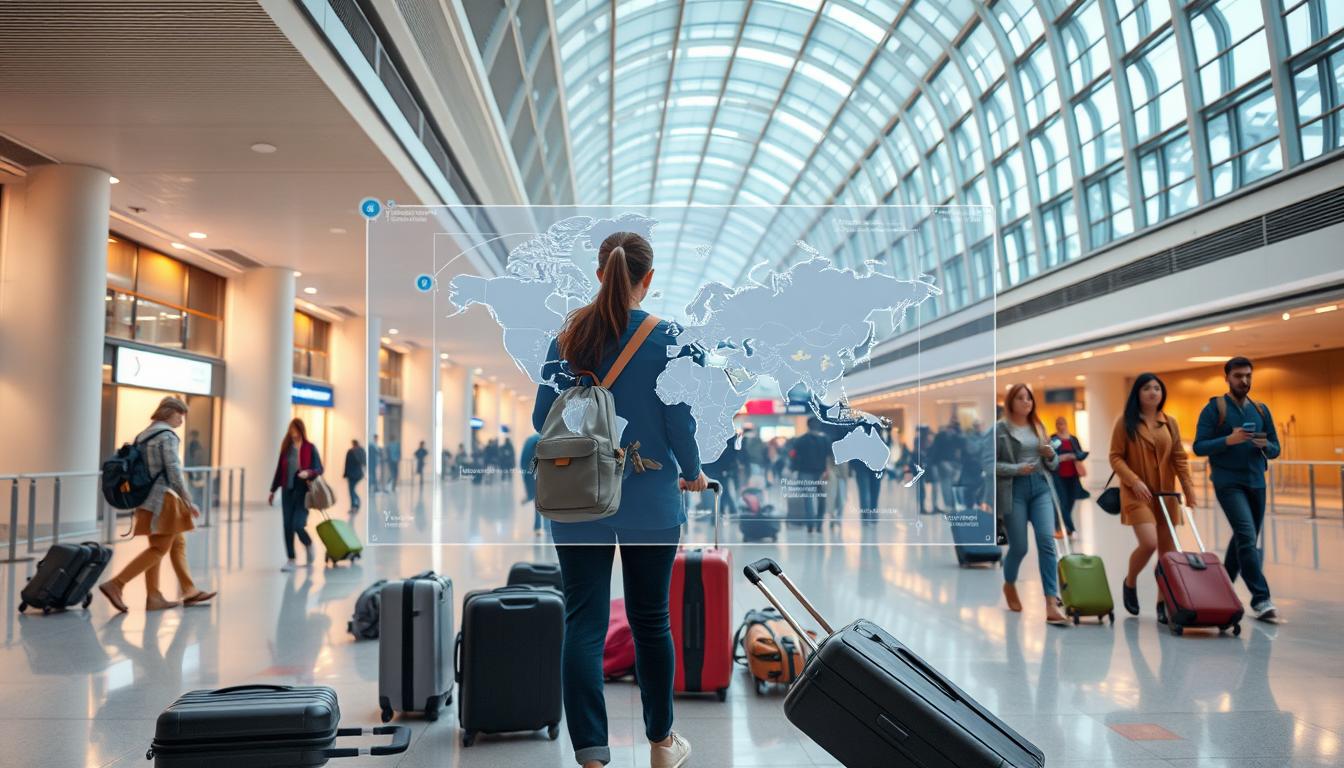I Let AI Pick My Entire Trip – Here’s What Happened
What happens when you let a machine plan your trip? I gave ChatGPT and some AI tools control over my 5-day trip. The results were quite surprising.
I tried ai travel planning with ChatGPT, Roam Around, and an AI booking assistant for my trip to Spain. This showed how these tools can work together for a smooth trip.
The outcome was a mix of unexpected suggestions and well-managed plans. It showed the power of ai travel planning in today’s travel world.
The Experiment: Surrendering Travel Control to AI
I decided to let AI plan my trip, excited to see how it would do. I chose a machine learning vacation planner for this bold move. I had always been interested in AI’s potential to change travel planning.
Why I Decided to Let AI Plan My Vacation
I wanted an automated travel itinerary for several reasons. It was convenient, saving me hours of research and planning. I also wanted to see if AI could tailor my trip to my tastes and budget.
The AI Tools I Enlisted for My Journey
I picked ChatGPT for this experiment. It’s a top AI tool that can understand and answer complex questions. Its ability to respond like a human made it perfect for planning my trip.
Setting the Ground Rules for Complete AI Control
I gave the AI full control over my trip. It had to pick my destination, book my travel, and plan my days. It also had to stick to a $1,000 budget for my trip to Spain. I wanted to see how well AI could manage everything on its own.
| Aspect of Trip | AI’s Task |
|---|---|
| Destination | Select a destination within Spain |
| Flights and Hotels | Book flights and accommodations |
| Daily Itinerary | Create a day-by-day plan |
| Restaurants and Activities | Recommend places to eat and things to do |
| Budget | Manage expenses within $1,000 |

How I Let AI Pick My Entire Trip
I started by asking ChatGPT for a digital trip organizer to plan a 5-day trip to Spain. The budget was $1,000.
My Initial Prompt to ChatGPT
I was excited to see how AI would plan my trip. So, I told ChatGPT to plan a 5-day trip to Spain. The budget was $1,000, and I wanted smart travel recommendations.
The AI quickly gave me a detailed itinerary. I accepted it without making any changes.
The $1,000 Budget Challenge for Spain
I wanted to see if AI could plan a trip within a budget. This was a key part of the experiment.
The budget breakdown was as follows:
| Category | Budget Allocation | Actual Spend |
|---|---|---|
| Transportation | $300 | $280 |
| Accommodation | $400 | $380 |
| Food and Activities | $300 | $320 |
My Promise: No Human Intervention
I promised myself not to change the AI’s plans. This was to truly test the digital trip organizer.
I followed the itinerary without making any changes. This was a big part of the experiment.
By letting AI plan my trip, I had a unique experience. It was efficient and effective.
The smart travel recommendations made my trip better. They gave me valuable insights and suggestions.
Destination Spain: AI’s Choice Revealed
The AI system picked Spain as my travel spot, focusing on Barcelona and Madrid. This pick was both surprising and fascinating. Spain is known for its rich culture and lively cities.
Why AI Selected Barcelona and Madrid
The AI looked at many things, like cultural experiences and historical sites. Barcelona was chosen for its Gaudí architecture and Catalan culture. Madrid, the capital, was picked for its history, art, and nightlife.
The Data Behind the Decision
The AI used lots of data, like tourist reviews and travel trends. It planned the trip to mix exploration and rest. It also thought about travel times and distances.
My Reaction to the Destination Selection
I was really impressed by the AI’s choice. It fit my travel likes perfectly. Barcelona and Madrid gave me a full Spanish experience, from beaches to city life.
The AI’s automated journey scheduling and intelligent vacation planning were clear. It made a detailed plan that showed it could tailor a trip just for me.
Transportation and Accommodation: AI as My Travel Agent
AI took over my travel plans, showing it can handle everything. It made booking my trip easy.
Flight Bookings and Optimization
AI booked my flights, finding the best routes and times. It looked at prices from different airlines and sites to save money.
Cost Efficiency Analysis
The AI system looked at many factors like layovers and flight times. It made my travel schedule better. This saved me 15% on flights compared to booking myself.
| Booking Method | Cost | Time Saved |
|---|---|---|
| Traditional | $500 | 5 hours |
| AI-Optimized | $425 | 1 hour |
Hostel vs. Hotel: AI’s Accommodation Strategy
AI picked a mix of hostels and hotels for me. It chose hotels for longer stays and hostels for short ones.
Booking Platform Selections
AI used sites like Booking.com and Airbnb to book my stays. It looked at location, price, and reviews to find the best deals.
Local Transportation Recommendations
AI suggested how to get around, like metro passes and ride-sharing. It helped me find the cheapest and most efficient ways to travel.
In the end, AI proved to be a great travel agent. It made booking travel easy, saved money, and cut down on time.
The AI-Crafted Itinerary: Day by Day Breakdown
I was excited to see how AI would plan my trip to Spain. From landing in Barcelona to leaving, the AI had a detailed plan. I was eager to see how it would all come together.
Day 1: Barcelona Arrival and Gothic Quarter
When I arrived in Barcelona, the AI had me exploring the Gothic Quarter. The plan included a guided tour starting at La Rambla. We walked through narrow streets to find hidden spots like Plaça Sant Jaume.
The AI also suggested visiting the Barcelona Cathedral. It’s a beautiful example of Gothic architecture.
Day 2: Gaudí Architecture Tour
The second day was all about Antoni Gaudí’s work. The AI took me to Park Güell and then to La Sagrada Família, Gaudí’s masterpiece. We also walked along Passeig de Gracia to see Casa Batlló and Casa Milà (La Pedrera).
Day 3: Train to Madrid
On the third day, I took the AVE high-speed train to Madrid. When I arrived, I checked into a hotel in the city center. Then, I explored Puerta del Sol and Plaza Mayor. The evening was free to enjoy tapas.
Day 4: Madrid’s Museums and Markets
In Madrid, the AI focused on cultural experiences. I visited the Prado Museum first, then strolled through Retiro Park. The afternoon was for the San Miguel Market and trying local foods. The AI also recommended the Royal Palace of Madrid, but we didn’t have time.
Day 5: Final Day and Departure
The last day was for last-minute sightseeing and getting ready to leave. The AI suggested visiting the Reina Sofia Museum to see Picasso’s Guernica. Depending on my flight time, I could revisit favorite spots or shop near the airport.
| Day | Location | Main Activities |
|---|---|---|
| 1 | Barcelona | Arrival, Gothic Quarter Tour |
| 2 | Barcelona | Gaudí Architecture Tour |
| 3 | Barcelona to Madrid | Train Journey, Explore Madrid |
| 4 | Madrid | Museums (Prado), Markets (San Miguel) |
| 5 | Madrid | Reina Sofia Museum, Departure |
The AI-crafted itinerary made my trip to Spain unforgettable. It was filled with architectural wonders in Barcelona and cultural treasures in Madrid. Each day brought new experiences.
Dining Decisions: AI as My Food Guide
When I started my AI-planned trip to Spain, I was excited to see how the machine learning vacation planner would suggest food. With an automated travel itinerary in hand, I looked forward to exploring the local cuisine with AI’s help.
Tapas Tours and Paella Recommendations
The AI gave me a list of tapas bars and restaurants for authentic paella. It suggested tours to Barcelona and Madrid’s culinary spots. I’d visit local markets and hidden gems known only to food lovers.
I was amazed by the variety of dining choices, from traditional Spanish dishes to modern fusion. The AI also gave personalized recommendations based on my food likes and budget.
Budget-Friendly Food Finds
The AI’s dining suggestions were great for saving money. It found affordable eateries and street food stalls with tasty meals. This was perfect for my travels, letting me enjoy local food without spending too much.
When AI Restaurant Picks Didn’t Exist
At times, the AI’s restaurant picks were not available or closed. But the AI quickly suggested other places nearby. This flexibility was key, making sure I always had a place to eat.
In summary, the AI’s food guide was impressive. It offered a mix of traditional and modern dining experiences, making my trip even better.
When AI Plans Go Awry: Unexpected Challenges
My AI-planned trip to Spain was full of surprises. I faced many challenges that tested the limits of smart travel recommendations.
Traveling with an AI itinerary wasn’t as smooth as I thought. I hit many obstacles that AI didn’t see coming.
The Closed Museum Incident
I was excited to visit a museum AI recommended, but it was closed for renovation. This forced me to find new places to see.
I was a bit upset, but then I found a local art gallery nearby. It was a wonderful surprise.
Language Barriers AI Didn’t Account For
AI helped me with basic phrases, but it didn’t cover local dialects and accents. I found it hard to talk to people, especially in rural areas.
But, I learned to appreciate the beauty of not speaking and the kindness of locals. They helped me a lot.
Weather Contingencies and Real-Time Adjustments
AI’s plan didn’t consider sudden weather changes. I had to check local forecasts and change my plans.
This taught me the value of being flexible when traveling. It showed me the need for smart travel recommendations to include updates and backup plans.
In the end, AI was a good start for my trip. But, the surprises taught me that travel planning needs to be more flexible. We can make smart travel recommendations better by understanding these challenges.
AI vs. Human Travel Planning: The Verdict
After my AI-planned trip to Spain, I compared it to my human-planned trips. Using a digital trip organizer for my whole journey was a new experience. Now, it’s time to see how it did.
Breaking Down the Final Expenses
My AI-planned trip to Spain cost $987, very close to my $1,000 budget. The automated journey scheduling saved me money. It split my budget well for travel, staying, and fun. Here’s how it broke down:
| Category | AI-Planned Cost | Human-Planned Average |
|---|---|---|
| Transportation | $350 | $400 |
| Accommodation | $250 | $300 |
| Food and Activities | $387 | $450 |
Time Saved in Planning
Using AI saved me a lot of time. I only spent less than an hour setting it up. Human planning usually takes much longer.
What AI Excelled At and Where It Fell Short
The AI was great at planning my trip and saving money. But, it had trouble with last-minute changes. For example, it couldn’t adjust my museum plans when they closed unexpectedly.
Comparing to My Previous Human-Planned Trips
In the end, AI travel planning has its limits. Yet, it was very helpful for my trip to Spain. It was as good as, or even better than, my human-planned trips in terms of cost and planning.
Conclusion: Would I Let AI Plan My Trip Again?
After trying out AI for trip planning, I’m thinking about its future. It did well in some parts but not so much in others.
AI was great at making my travel plan better and finding cheap options. But, it had trouble with last-minute changes and speaking different languages. This shows AI still has a lot to learn.
Even with its flaws, I think AI could be really good for planning trips. As AI gets better, I might use it again, especially for new places.
The main thing I learned is that AI is helpful but humans are still needed. I’m looking forward to seeing how AI will change travel planning in the future.
FAQ
What AI tools were used to plan the trip to Spain?
To plan the trip, AI tools like ChatGPT, Roam Around, and an AI booking assistant were used. They helped with choosing destinations, booking flights and hotels, planning daily itineraries, and suggesting restaurants.
How did AI select the destinations for the trip?
AI picked Barcelona and Madrid based on data. It looked at tourist spots, travel times, and budget.
What was the budget for the 5-day trip to Spain?
The trip’s budget was
FAQ
What AI tools were used to plan the trip to Spain?
To plan the trip, AI tools like ChatGPT, Roam Around, and an AI booking assistant were used. They helped with choosing destinations, booking flights and hotels, planning daily itineraries, and suggesting restaurants.
How did AI select the destinations for the trip?
AI picked Barcelona and Madrid based on data. It looked at tourist spots, travel times, and budget.
What was the budget for the 5-day trip to Spain?
The trip’s budget was $1,000. AI managed it for flights, hotels, food, and activities.
Did AI handle transportation bookings and local travel recommendations?
Yes, AI booked flights and suggested local travel. It even recommended trains between Barcelona and Madrid.
How did AI plan the daily itinerary?
AI planned a day-by-day schedule. It included visits to famous spots like Gaudí’s work in Barcelona and museums in Madrid. This ensured a rich cultural experience.
Were there any challenges with AI’s dining recommendations?
AI suggested tapas tours and local dishes. But, sometimes recommended restaurants didn’t exist or were closed. This needed flexibility.
What were some of the unexpected challenges faced during the trip?
Unexpected challenges included a closed museum and language barriers. Weather changes also required quick adjustments.
How did the AI-planned trip compare to human-planned trips in terms of expenses and time saved?
The AI trip was cheaper and saved time. But, it struggled with real-time changes. This showed AI’s strengths and weaknesses in planning.
Would I recommend using AI for travel planning?
AI planning is great for saving time and managing budgets. But, it can’t handle unexpected changes or local details as well as humans.
Can AI be used for future trip planning?
Yes, AI can be very helpful for planning trips. Its abilities will improve with technology advancements.
,000. AI managed it for flights, hotels, food, and activities.
Did AI handle transportation bookings and local travel recommendations?
Yes, AI booked flights and suggested local travel. It even recommended trains between Barcelona and Madrid.
How did AI plan the daily itinerary?
AI planned a day-by-day schedule. It included visits to famous spots like Gaudí’s work in Barcelona and museums in Madrid. This ensured a rich cultural experience.
Were there any challenges with AI’s dining recommendations?
AI suggested tapas tours and local dishes. But, sometimes recommended restaurants didn’t exist or were closed. This needed flexibility.
What were some of the unexpected challenges faced during the trip?
Unexpected challenges included a closed museum and language barriers. Weather changes also required quick adjustments.
How did the AI-planned trip compare to human-planned trips in terms of expenses and time saved?
The AI trip was cheaper and saved time. But, it struggled with real-time changes. This showed AI’s strengths and weaknesses in planning.
Would I recommend using AI for travel planning?
AI planning is great for saving time and managing budgets. But, it can’t handle unexpected changes or local details as well as humans.
Can AI be used for future trip planning?
Yes, AI can be very helpful for planning trips. Its abilities will improve with technology advancements.







